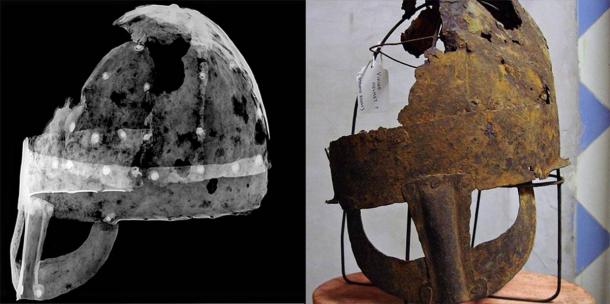A re-evaluation of a helmet discovered in Yarm has led experts to believe that it is the earliest Anglo-Scandinavian helmet ever to have been found in the British Isles. The remarkable Yarm helmet is one of only two nearly complete Viking helmets ever unearthed. The latest study can help experts to better understand the evolution of the helmet in the Viking Age and the Early Middle Ages.
The Yarm helmet is an example of ancient protective headgear and it was found in the 1950s by workmen in Stockton-on-Tees. According to Preston Park Museum , “the helmet is made of iron bands and plates, riveted together, with a simple knot at the top.” There are hammer marks on the Viking-era helmet indicating it was made by a smith. There is a “spectacle mask” that protected the eyes of the wearer. “The construction of the helmet is workmanlike and indicates that it was intended for use, not display,” states the Preston Park Museum website.

The Yarm helmet has been on permanent display at Preston Park Museum since 2012. Researchers from Durham University conducted radiographs of the Anglo-Scandinavian helmet to study the properties of the metal and compared the find to other archaeological discoveries. ( Durham University )
Renewed Investigation of 1950s Discovery
The helmet cone is about 1 inch thick and would have been able to absorb a blow from a sword. Much of the cone of the Yarm helmet is missing and the artifact is corroded. Despite this, the helmet is an exceptionally important historical find. For several decades the helmet has been on loan to Preston Park Museum from Yarm Town Council. Despite being of great importance, it has never been systematically investigated by researchers and there has been debate as to the origin of the Viking headgear.
In recent years Dr. Christ Caple, from Durham University, has examined the rare helmet with his colleagues. They have compared the artifact with the other archaeological discoveries and have analyzed the properties of the headgear’s metal. Stockton-on-Tees Council states that the researchers have established that it is an “Anglo-Scandinavian helmet made in the 10th century in northern England.” This is much earlier than anyone had previously believed.

Vikings were feared for their vicious raids and attacks. This 1901 painting by Ferdinand Leeke shows them with their signature helmets which were used as essential personal protective equipment by Viking warriors. ( Public domain )
First Anglo-Scandinavian Helmet Found in Britain
The Northern Echo quoted Dr. Caple as stating: “It was a challenging project, as the thin iron sheet is now very susceptible to corrosion (it has to be kept in very dry conditions).” One mystery that was solved by Caple and his colleagues was how the rare artifact survived. The helmet was discovered in a water-clogged environment. It only began to corrode in later years, so it’s fortunate that it was unearthed by the workmen, or else it would have disintegrated. For some reason, the object was hidden in a pit or hole.
The Northern Echo quotes Dr. Capel as saying that “this is the first Anglo-Scandinavian (Viking) helmet from Britain.” That is, it was probably made in England by Vikings who had settled in the region. Viking helmets were an important piece of protective equipment, designed to be functional and give warriors a real advantage on the battlefield.

Viking-era helmet discovered in 1943 at Gjermundby farm in southern Norway. The Gjermundbu helmet is one of two nearly intact Viking helmets discovered to date, the other being the Yarm helmet. Viking helmet fragments capable of reconstruction have also been discovered in Tjele, Gotland and Kiev. ( NTNU Vitenskapsmuseet / CC BY-2.0 )
Evolution of the Helmet: How the Viking Helmet Differed From Its Counterparts
Capel is quoted by The World News as saying that “together with a mail hauberk (shirt of chain mail), a helmet was essential personal protective equipment for a warrior.” Anglo-Saxon helmets were unlike their Viking counterparts in that they were highly ornate and were symbols of status. The Vikings revolutionized helmet design. As a result, the protective headgear became more common in English and other armies, as is evident from the Bayeux tapestry .
Only one other near intact Viking helmet has been discovered to date, found in Gjermundbu, southern Norway. This also dates to the 10 th century AD and was also deposited in a pit, for reasons no one has yet been able to ascertain.

While popular culture has depicted Vikings as having helmets decorated with horns, antlers or wings, this image only entered collective imagination in the 19 th century due to artistic and literary fancy. In the diorama above, Vikings can be seen wearing helmets like the one discovered in Yarm, without horns, at the Archaeological Museum in Stavanger, Norway. ( Wolfmann / CC BY SA 4.0 )
Viking Raiders of the British Isles
The Vikings first came to Britain as raiders and would regularly pillage churches and monasteries. Later they began to settle in England, especially in the North. During the 10 th century, when the helmet was made, many of them had submitted to the English king and had become Christians. However, by the end of the 10 th century AD, there was an increase in Viking raids from the Kingdom of Denmark. By the end of the century, the Danes were being paid a massive tribute by the English king to cease their attacks on his kingdom.
The local council is very excited by the results of the study. Councilor Jim Beall told The Northern Echo that he is proud that the local museum has “a very rare example of a Viking helmet and the first to be found in Britain.” The Viking helmet has boosted the numbers of visitors to the museum. The full results of the study have been published in the Journal Medieval Archaeology .
Top image: Researchers have re-evaluated a helmet discovered in the 1950s in Yarm, Stockton-on-Tees. Known as the Yarm helmet, this is the first Anglo-Scandinavian helmet to have been discovered in Britain and is the second nearly complete Viking-era helmet discovered in the world to date. Source: Durham University .
By Ed Whelan
 RSS Feed
RSS Feed















 August 10th, 2020
August 10th, 2020  Awake Goy
Awake Goy  Posted in
Posted in  Tags:
Tags: 













